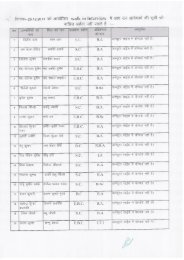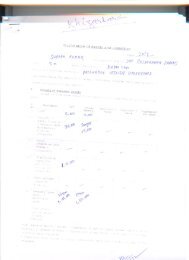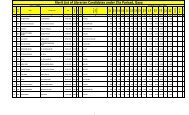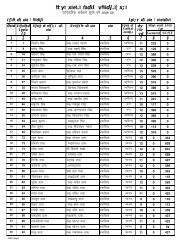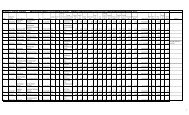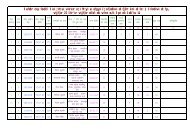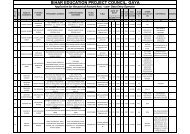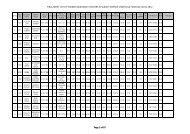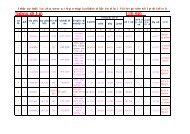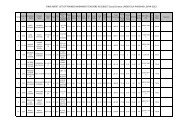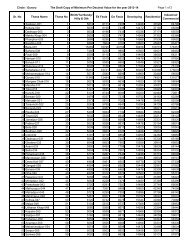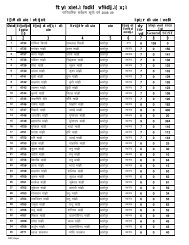Create successful ePaper yourself
Turn your PDF publications into a flip-book with our unique Google optimized e-Paper software.
Bodhgaya Temple Management Committee<br />
Blissful Bihar<br />
BIHAR TOURISM<br />
<strong>Cultural</strong> <strong>Programme</strong><br />
DISTRICT ADMINISTRATION,<br />
GAYA
Messages<br />
Bodh Gaya, the seat of Buddha's<br />
enlightenment is the most sacred pilgrimage for<br />
Buddhism as it is associated with the awakening<br />
of the Lord Buddha after six long years of<br />
meditation, self-deprivation and wandering.<br />
People come here in search of inner peace, to find<br />
solace at this immaculate place. Bodh Gaya<br />
symbolizes truth, peace and harmony.<br />
This land of awakening belongs to all<br />
looking for a soulful retreat, all sections of people; this seat of knowledge<br />
belongs to the world.<br />
Like every year in this 2013 we again celebrate knowledge,<br />
truth, art, peace at the Bodh Mahotsava. We celebrate Buddha- the<br />
enlightened one.<br />
Sunil Kumar 'Pintu'<br />
Minister Tourism<br />
Government of Bihar<br />
Tourism department Bihar is priveleged to<br />
be a part of Bodh Mahotsava, the annual tribute to<br />
the teachings and legacy of Gautam Buddha.<br />
BodhGaya is not only the seat of the enlightenment<br />
of Buddha, but also the spiritual soul and<br />
confluence of all the streams and practices of<br />
Buddhism in the world.<br />
Such a variegated legacy needs a vivid<br />
multicultural presentation and that is what we have<br />
attempted to present before all of you. The theme of<br />
this celebration is knowledge, peace and prosperity and our endeavour<br />
is to bring out all the facets of Buddhism in an enjoyable program.<br />
The support of Gaya district administration and BTMC has , as<br />
always, been exceptional and they deserve our thanks. This compilation<br />
of the events and inking it in a brochure will indeed be a landmark, and I<br />
hope it becomes a collector's item.<br />
Wishing all of you a Happy and enjoyable Bodh Mahotsava and the<br />
creators of this brochure a grand success.<br />
Mihir Kumar Singh<br />
Secretary,<br />
Deptt. of Tourism, Govt. of Bihar
Message<br />
Dear Friends,<br />
Mahabodhi Temple at Bodh Gaya architecturally commemorates the<br />
place where Siddhartha Gautam attained Enlightenment. Various<br />
traditions ascribe the erection of the very first temple at this site to<br />
Emperor Ashoka who ruled over the Magadha<br />
rd<br />
region in the 3 century BCE. He visited Bodh<br />
Gaya in about 260 BCE and marked this site<br />
with his trademark pillar which still stands<br />
within the Temple's precincts. Ashoka not only<br />
embraced Buddhism but is also responsible<br />
for its spread to Sri Lanka and all over South-<br />
East Asia. The site of Mahabodhi Temple<br />
Complex including the Vajrasana and Bodhi<br />
Tree, identified by the Emperor Ashoka, is a<br />
World Heritage Site today. We dedicate Bodh<br />
Mahotsava - 2013 to this great King of Peace<br />
for his contribution towards the spread of<br />
Buddhism and promoting universal botherhood and harmony<br />
worldwide. We have befittingly chosen the topic of Seminar to be held<br />
on the occasion of Bodh Mahotsava as Emperor Ashoka and<br />
Buddhism and have organized many cultural performances around<br />
this central theme.<br />
The three day Bodh Mahotsava is aimed at promoting the<br />
exchange of cultural activities as a global community and also to<br />
showcase the rich traditions of our country. On the first day<br />
international cultural troupes and ethnic groups from the Buddhist<br />
regions of India through their performances illustrate how Buddhism<br />
and its tenets are intrinsically interwoven into the daily lives of the<br />
believers. The second day is devoted to the vibrant culture, glorious<br />
history and magnificent art forms of Bihar. On the third day we bring<br />
together the various regional martial art forms of the country and also<br />
have performances exhibiting the cultural, artistic and linguistic<br />
diversity of the incredible nation that is India. Apart from cultural<br />
programmes and seminar we also have handicraft and painting<br />
exhibitions, peace walk, documentary shows and all faith prayer meet<br />
planned over a period of three days to celebrate the confluence of<br />
peace, prosperity and harmony.<br />
Bodh Mahotsava, held every year in the first week of<br />
February, is increasingly becoming one of most awaited events of the<br />
Buddhist calendar. We are truly humbled by the overwhelming<br />
response to it from tourists, scholars, pilgrims and all others from India<br />
and abroad.<br />
Thank you all for joining us in paying this annual tribute to timeless<br />
celebrations.<br />
Bandana Preyashi, IAS<br />
Collector and District Magistrate, Gaya, Bihar<br />
-cum- Chairperson, BTMC
Day - 1<br />
Bhutan<br />
Composed by the 70th Chief<br />
Abbot, Je Trulku Jigme<br />
Choeda, the song is a form of<br />
tribute to the Gods, the<br />
spiritural master,the king and<br />
the people who have preserved<br />
peace and happiness in Bhutan,<br />
the land of 'Thunder Dragon'.<br />
6th February, 2013<br />
LU CHOED CHI LHADA : Welcome song<br />
PACHHAM - Dance of the Heroes<br />
Pemalingpa saw Guru<br />
Padmasambhava, a great<br />
spiritural master, in the center<br />
of a limitless mandala made of<br />
lines of rainbow in one of his<br />
visions.He saw the various<br />
emanations of peaceful and<br />
wrathful deities manifested in<br />
the mandala,of which the most<br />
important was an assembly of<br />
the heroes(Pawos) and the<br />
heroines(Khandoms). The dance was performed to lead the<br />
deceased into the presence of Guru Padmasambhava<br />
MERAK SAKTEN PI ZHABDRO<br />
Songs & Dances from the high landers of the Eastern Bhutan<br />
This is a folk song and dance from the two villages of Merak and<br />
Sakten, where lives a small group of sem-nomadic people with<br />
their distinctive<br />
dress and<br />
language. The<br />
song is an<br />
expression of the<br />
union of inner<br />
and outer,the<br />
physical and the<br />
spiritural, both considerd very important for the attainment of<br />
enlightenment.<br />
1
Day - 1<br />
TASHI LAYBEY<br />
Concluding Song and Dance<br />
Tashi Labey is a song and dance that wraps up social and cermonial<br />
gatherings in Bhutan. Usually, everybody present at the gathering<br />
participates in this dance.The song solicits divine blessings of long<br />
life, prosperty and happiness for all those present-host, guests and<br />
spectators, and ends with wishes to meet in similar occasions in<br />
future. Performance by : Royal Academy of Performing Arts, Royal<br />
Government of Bhutan<br />
Japan<br />
Masako Ono<br />
Masako Ono trained in<br />
western classical ballet at the<br />
Matsuyama Ballet in Tokyo,<br />
and studied jazz dance and hip<br />
hop at the K-Broadway Dance<br />
Center, Tokyo. In 1996, Ono<br />
joined Nrityagram and<br />
received training in Odishi.<br />
She also attended classes in<br />
Yoga, Kalaripayattu and<br />
Mayurbhanj Chhau dance.<br />
After five years of training in Odissi and yoga, she left Nrityagram<br />
to become a solo performer. Since 2001, Ono has been based at<br />
Bhubaneswar as a professional Odissi dancer and yoga teacher,<br />
collaborating with dancers, musicians and artists from India and<br />
abroad. She has performed and given lecture-demonstrations and<br />
workshop in India, Japan, USA, Canada, Italy, Sweden, Australia,<br />
France, Malaysia, Singapore, Thailand, Indonesiaand Sri Lanka.<br />
Sri Lanka<br />
Gini Sisila & Naga Gurulu Dance :<br />
This is a traditional<br />
dance from Sri<br />
Lankan Low country<br />
area. The dance is<br />
dedicated to Ginisila,<br />
the God of<br />
Soonaiyam Yaga. The<br />
dance depicts the<br />
performance of 18<br />
Sanni dance joined by<br />
Naga Gusulu dance.<br />
This dance is mainly<br />
performed by males.<br />
2
Day - 1<br />
Wes Dance :<br />
Sri Lankans perform three main<br />
traditional dances. The First one<br />
is up country dance, second one is<br />
low country dance and third one<br />
is sabaragamuwa. This is an up<br />
country dance depicting prayer to<br />
God to get freedom from<br />
suffering of illness and is called<br />
Shanti Karma. Dancers are<br />
adorned with beautiful cloths and traditional jewellerys.<br />
Gopi dance :<br />
This is a folk dance performed on the<br />
paddy fields and it depicts happy<br />
village life of Sri Lanka in simple<br />
cloths & jewellery showing how they<br />
spread agriculture growth in villages.<br />
Performance by : Jayapathi Rangayatana<br />
Dancing group, Sri Lanka<br />
Leh<br />
JABRO DANCE :<br />
In eastern Ladakh bordering Tibet,<br />
Changpa nomads have their Jabro<br />
dance and music characterized by<br />
rhythmic thumping of feet on a<br />
melodious song and music of Daman.<br />
The nomads live in tents at high<br />
altitude pastures in vast stretches of<br />
Changthang wilderness with their<br />
livestock including Yaks, Sheep and<br />
goats. The relatively fast movement in their dance helps them warm<br />
up during celebrations.<br />
CHARTSES DANCE :<br />
In Ladakh numerous migratory<br />
birds are found. The arrival of<br />
migratory birds in highlands of<br />
Ladakh is considered<br />
auspicious. The dance of<br />
Chartses (birds dance) signifies<br />
the arrival of migratory birds<br />
and is performed as an<br />
appreciation for these birds.<br />
This dance form performed by<br />
females, is choreographed with movements like birds.<br />
Performance by : Kunfan Art & Culture Society, Leh<br />
2
Sikkim<br />
Tamang Sello<br />
This dance is integral to Nepali community<br />
called Tamangs. The dancers create a<br />
magical aura when they match their steps to<br />
the sound of the musical instrument called<br />
Damphoo. An ensemble of fun, vigour and<br />
brisk movements to the beats of Damphoo is<br />
peculiar to this dance form. Marriage<br />
ceremonies, fairs and child births are the<br />
ceremonies when this dance is performed.<br />
Day - 1<br />
Maruni<br />
Maruni is one of the most<br />
graceful dance forms in the rich<br />
and resplendent repertoire of<br />
Nepalese performing arts. The<br />
dance is accompanied by a<br />
wide variety of songs, sung on<br />
the beats of Madal, that portray<br />
diverse colours of life.<br />
Ghantu<br />
The Ghantu dance is a<br />
Sikkimese folk dance<br />
patronized by the Gurung<br />
community of the state. The<br />
ancient folk dance form<br />
depicts the colorful lifestyle<br />
of the people of the land. The<br />
dance, which is full of fun and<br />
vigour is performed by young<br />
girls wearing traditional<br />
costumes and headgear.<br />
Performance by : Naren Gurung & group<br />
Dharamshala<br />
Dramnyen Shapdro: the dance of the Lute player<br />
Dranyen which in Tibetan means Melody, is a fretless lute<br />
instrument. The instrument features prominently in songs and<br />
dances from Western, Central and North eastern Tibet. Depending<br />
3
on the pitch of the sound, the<br />
instrument comes in different<br />
sizes. In this folk dance, the<br />
musicians display a variety of<br />
traditional quick stepping dance<br />
which are very popular within<br />
central Tibet.<br />
Seng-geh Gar-cham: the Snow Lion Dance<br />
In Tibet the snow lion symbolizes<br />
the fearless and elegant quality of<br />
the enlightened mind. When a<br />
healthy and harmonious<br />
environment is established by the<br />
creative activities of human beings,<br />
such as through the performance of<br />
sacred purification and healing<br />
music, all living beings, here<br />
represented by the snow lion,<br />
rejoice. The Snow lion dance of Tibet is a very symbolic dance art<br />
form. According to Buddhist beliefs, snow lions are considered as a<br />
good omen. The snow lion does not exist in real life, but a myth<br />
which symbolizes fearlessness and happiness.<br />
Performance by : Tibetan Institute of Performing Arts<br />
7th February, 2013<br />
Thumari & Tappa : Pandit Govardhan Mishra<br />
Gaya has been a centre of excellence<br />
in classical music, particularly of<br />
Tappa and Thumri variety. Pandit<br />
Govardhan Mishra of Gaya is<br />
perhaps the most versatile living<br />
exponent of Tappa singing in the<br />
country today. He has performed at<br />
many prestigious festivals in the<br />
country for many decades. He has<br />
recorded a large number of traditional<br />
“bandish” of Tappa, Thumri and dadra and his musical<br />
compositions have been regularly broadcast by the AIR. He has<br />
been honoured with the prestigious Sangeet Natak Akademi award.<br />
4
Day - 2<br />
Dadra, Holi and Chaiti : Rajendra Sijuar<br />
Born in a musical family, Rajender Sijuar of<br />
Gaya got his training in vocal music from late<br />
Pandit Jayram Tiwari and renowned vocalist of<br />
Bihar Pandit Kameshwar Pathak. A proponent of<br />
Gaya Gharana, he sings the Khhayal variety as<br />
well as the light classical styles of Thumri,<br />
Dadra, Kajri, hori Chaiti, Baramasa, Shawani,<br />
Jhoola and Bhajan. He has also improvised upon<br />
Raga Tala and tonal quality of voice<br />
Tayarai/Layakari and is a torch bearer of Gaya Gharana 'Purabang'.<br />
Jhijhia: Nitu Kumari 'Nootan'<br />
One of the most eminent traditional folk dances of Bihar, Jhijhia<br />
depicts a group of young women adoring and offering prayers in<br />
the form of song and dance to please the king of Gods, Lord Indra,<br />
for rains and for better yield. The<br />
dancers sing and dance to please<br />
the Lord of Rain, with their deep<br />
devotion. On their heads the<br />
performing women carry lanterns<br />
(pots made of clay) with several<br />
holes and diyas (candles lit with<br />
mustard oil) inside, thus allowing<br />
light to come out through the holes.<br />
Women purposely dance slowly<br />
with lanterns on their heads so that the holes can be counted. It is<br />
usually performed during the great festival Vijaya Dashmi. Nitu<br />
Kumari 'Nootan' and her troupe shall be performing this folk dance.<br />
Uttar Priyadarshi : A play by Sanjay Upadhayay<br />
Uttar-Priyadarshi (The Final<br />
Beatitude) focuses on the spiritual<br />
journey of King Ashoka, the<br />
second-century B.C. emperorwarrior<br />
who ultimately renounces<br />
violence, adopts the eightfold path<br />
of the Buddha and becomes known<br />
as the Priyadarshi, or “one who<br />
looks with compassion". It is a<br />
dramatic spectacle, incorporating<br />
song and speech, dance and gesture, bold color and light in a highly<br />
stylized and ritualistic fashion.<br />
Sanjay Upadhaya, the director of the play, is an NSD graduate and<br />
also the director of Nirman Kala Manch and Safarmaina based in<br />
Bihar. He is a leading theatre artist of the state with deep grounding<br />
6
Peacock and Flower Holi Dance : Gitanjali Sharma<br />
Day - 2<br />
in folk music and traditional theatres. Music is the soul of the<br />
majority of his productions. As stage director his other acclaimed<br />
works include “Bedesia”, “Parti Parikatha”, “Kahan Gaya Mere<br />
Ugna” and “Harsingar”.<br />
The Mayur or peacock dance is<br />
created from an episode in the love<br />
lore of Radha and Krishna. Radha,<br />
pining for Krishna after a brief<br />
separation, decides to console herself<br />
by the sight of peacocks. Krishna,<br />
knowing her mind from afar,<br />
playfully causes the peacocks to<br />
disappear, leaving Radha distraught.<br />
He eventually yields to Radha's<br />
entreaties and himself appears in<br />
the guise of a peacock to dance<br />
with his beloved.<br />
Holi is celebrated in different<br />
ways and flower holi is a joyful<br />
celebration of holi in the Braj<br />
region. The festivities include<br />
colour processions with music,<br />
song and dance amongst the<br />
gopas and gopis. Both dances<br />
belong to the Braj region of Uttar<br />
Pradesh with its core at Mathura<br />
and Vrindavan, places associated with Lord Krishna.<br />
Gitanjali Sharma is a renowned dancer who stays at Braj and has<br />
national and international shows to her credit.<br />
Gatka & Giddha : Punjab<br />
8th February, 2013<br />
Gatka is a weapon-based martial art<br />
associated with the Punjab region.<br />
The word gatka properly refers to<br />
the wooden sticks which were used<br />
for sparring. While it is primarily an<br />
armed fighting style, gatka also<br />
incorporates pehlwani as part of its<br />
empty-handed training component.<br />
Gatka is practiced either as a sport or<br />
a ritual. Performance by : Satpal Bagi & group<br />
7
Giddha is a popular folk dance<br />
of women in Punjab region. It is<br />
a very colourful dance form<br />
which is performed by women<br />
at festive or social occasions.<br />
Women dance in a circles<br />
wearing bright coloured clothes<br />
complemented by heavy<br />
jewellery. Performance by : Ajit<br />
Singh & group<br />
Day - 3<br />
Bardai Shikhla & Bhortal Dance : Assam<br />
Bardai Shikhla is a dance of<br />
Bodos in Assam. The dance<br />
symbolizes the furious wind with<br />
rain that flows on the earth before<br />
the new year. The wind wishes to<br />
destroy the old to prepare the<br />
earth for new days of production.<br />
Young girls, symbols of Nature, do a speedy dance accompanied by<br />
flute and drums.<br />
BHORTAL is a big cymbal made of brass<br />
used while singing prayers. It is a dance in<br />
praise of God. Six to ten dancers equipped<br />
with cymbals perform this dance and<br />
produce a good number of attractive<br />
formations displaying the cymbals. The<br />
dance can be seen during festive occasions<br />
in and around Barpeta and Guwahati.<br />
Performance by : Alayaron Harimu Afad of<br />
Alha and Udal : Jaunpur, UP<br />
Alha and Udal were great fighters of Bundelkhand. According to<br />
folklore, Alha was invincible, made immortal by the goddess<br />
Sharda. Alha gifted his head to Sharda<br />
after cutting it off with a sword. The<br />
goddess, extremely pleased by the act,<br />
made him immortal. Udal was younger<br />
brother of Alha. Udal was generally<br />
seen on a horse whereas Alha, on an<br />
elephant. Both are among the greatest<br />
Rajput warriors of all times and their<br />
story narrated by Fauzdar Singh<br />
emphasis the honour and valour of<br />
kshatriya warriors. Performance by :<br />
Fauzdar Singh & group<br />
8
Dhedhia and Jhumar : Allahabad, U.P.<br />
Day - 3<br />
Dhedhia is a folk dance of<br />
Prayag region in Uttar Pradesh.<br />
It is believed that when God<br />
Rama along with his wife Sita<br />
and brother Lakshaman<br />
reached the land between the<br />
rivers Ganges and Yamuna,<br />
people thought that Shani was<br />
also accompanying them invisibly. So the people performed some<br />
rituals to avoid Shani's effect. In due course the tradition developed<br />
into Dhedhia folk dance, where females use earthen utensils with<br />
lamp inside for well wishing their male relatives.<br />
Jhumar is a traditional folk song<br />
of U.P. and Bihar. This is sung<br />
specially in spring and in rainy<br />
season and is named as Fagvi and<br />
Savani Jhumar respectively. This<br />
folk song is sung in 'Dadra' and<br />
'kaherva' Tal. Due to more<br />
emphasis on 'Shringar Ras' in<br />
jhumar, people often use this for<br />
their dancing ceremonies.<br />
Performance by : Anand Kishore & group.<br />
Chhau : Jharkhand<br />
Chhau dance of Seraikella, in<br />
Jharkhand once a princely<br />
State, is one of the main ancient<br />
and classical schools of Indian<br />
Dances along with the<br />
Kathakali, Bharatnatyam,<br />
Manipuri and others. The<br />
Chhau dance of Seraikella is a<br />
Mask Dance. It has now made it<br />
to the UNESCO list of world<br />
intangible cultural heritage<br />
during the fifth session of UNESCO in 2010.<br />
Performance by : Sri Kala Peeth, Seraikella<br />
Lamp Dance : Goa<br />
The lamp dance is so called because of the brass lamps that are used<br />
to perform this dance. The dancers have to dance very slowly<br />
balancing heavy brass lamps on their heads. The music is usually<br />
9
instrumental and folk<br />
instruments like ghumat,<br />
samael, cymbals and<br />
harmonium are used. This<br />
dance requires immense selfcontrol<br />
and discipline in order<br />
to balance the lamps and dance.<br />
Performance by : Shantadurga<br />
<strong>Cultural</strong> Association,<br />
Kumbharjua, Goa<br />
Pai Danda : Mahoba, U.P.<br />
Day - 3<br />
Pai Danda is a famous folk<br />
dance of Uttar Pradesh. It is<br />
themed around the childhood<br />
pranks and frolics of Lord<br />
Krishna. It depicts the mock<br />
fights that the lord had with the<br />
cowherd boys, with whom he<br />
spent his early years. The<br />
dancers in Pai Danda hold<br />
sticks measuring one and half<br />
feet long. They engage in mock<br />
battles in pairs, periodically changing positions and angles. The<br />
dance starts along the song. Gradually the dancers pickup the pace,<br />
with the steps gathering momentum. The overall performance is<br />
given accompaniment by the beats of folk drums like the Dholak<br />
and Nagara. Performance by : Ramchandra Yadav and group.<br />
Lezim : Nagpur, Maharashtra<br />
Lezim is a folk dance form<br />
from of Maharashtra and can<br />
trace its origins from the time of<br />
Peshwas. Dancers carry a small<br />
musical instrument with<br />
jingling cymbals called the<br />
Lezim, after which the dance<br />
form is named. The dance is<br />
frequently used as a fitness drill<br />
by schools, militias and other<br />
institutions because it involves<br />
many calisthenic moves and can be quite strenuous. Lezim<br />
traditionally was done to create an atmosphere of courage and<br />
valour before the battle.<br />
Performance by : Maharashtra Lezim Association.<br />
10
Day - 3<br />
Thang-ta & Basant Raas : Manipur<br />
Thang-ta or huyen lallong is a<br />
weapon-based Indian martial art<br />
created by the Meitei of Manipur.<br />
In the Manipuri language, thang<br />
means sword and ta means spear.<br />
As its name implies, the sword and<br />
spear are the primary weapons in<br />
thang-ta. The spear can be used in<br />
its non-missile form while in close<br />
or thrown from afar. Other<br />
weapons used include the shield and axe.It was used with great<br />
success by the Manipuri kings to fight against the European<br />
colonists and was subsequently banned during the British<br />
occupation. Today thang-ta is the most popular of Meitei martial<br />
arts, practiced by both men and women.<br />
Basant Ras is a rasleela or night<br />
long ritual dance drama from<br />
Manipur. In the full moon of<br />
spring Lord Krishna comes to the<br />
appointed grove, the gopis led by<br />
Radha responds to the call of his.<br />
They dance together and play holi<br />
by smearing abir on each other.<br />
Performance by : The Huyen Lallong<br />
Thang-ta <strong>Cultural</strong> Association Manipur<br />
Salim Arif: Director-Choreographer<br />
Salim Arif, the Director-Choreographer of the Bodh Mahotsava-<br />
2013, is an alumnus of National School of Drama, New Delhi. A<br />
well known name of Indian theatre<br />
and films, he is currently working as<br />
the Head of Department of Actors'<br />
Studio in Whistling Woods<br />
International, Mumbai. He has made<br />
his mark as Director-Choreographer<br />
of important national events with<br />
Drums of India and Wind<br />
Instruments of India, shows for<br />
Republic Day Parade, Shyam<br />
Benegal's Bharat Ek Khoj, Gulzar's<br />
Mirza Ghalib among others. Dr.Chandraprakash Dwedi's<br />
Chanakya got him International recognition as a Period Film<br />
Designer of substance. His plays, Aap Ki Sonia, Kharaashein and<br />
Ghalibnaama have made him one of the most exciting and popular<br />
director on Hindi theatre scene in India.<br />
11
Seminar<br />
Emperor Ashoka and Buddhism<br />
Ashoka of Maurya Dynasty (269 -232 BCE) is a well-known as<br />
the King of Peace. He lived for about seventy years, and ruled for nearly<br />
forty years over most of the present day India. His reign was<br />
headquartered in Magadha, the present day Bihar. After a terrible war<br />
against the Kalingas (modern-day Orissa) where over one hundred<br />
thousand people were killed and even more were wounded or taken<br />
captive and deported, Ashoka showed deep remorse and decided to fully<br />
embrace Buddhism and to forswear forever the wars of aggression. In its<br />
place he established his vision of 'conquering of righteousness', the<br />
victory of 'Dharma'. Dharma as Buddha's Dhamma: the system of the<br />
universal laws of life by humaneness and righteousness, the basis of any<br />
religion. Various traditions ascribe the erection of the very first temple of<br />
Mahabodhi at Bodhgaya to Ashoka. It is mentioned in the Rock Edict VIII<br />
Ashoka or Devanmpiyadarshin visited Bodhgaya in the tenth year of his<br />
coronation. Without Ashoka Buddhism would not have become what it is<br />
now. It was his son Mahindra and daughter Sanghamitra, who brought<br />
Buddhism to Sri Lanka, from where it could spread all over South East<br />
Asia.<br />
Venue : Meditation Park Mahabodhi Temple, Bodhgaya<br />
on 7th Feb. 2013 (9 am to 4 pm)<br />
Speakers:<br />
1. Dr. Rajendra Ram, Vice-President, International Meditation Centre,<br />
Buddhagaya<br />
2. Dr. Sukomal Chaudhary, Former Principal, Govt. Sanskrit College,<br />
Calcutta<br />
3. Ven. Dr. Varasambodhi Thera, General Secretary, International<br />
Meditation Centre, Bodhgaya<br />
4. Dr. Sumanapal Bhikkhu, Assistant Professor, Deptt. of Tibetan<br />
Language, University of Calcutta<br />
5. Dr. Daisy Narayan (Banerjee), Professor of History, Patna University<br />
6. Dr. Saswati Mutsuddy, Reader, Deptt. of Pali, University of Calcutta.<br />
7. Dr. (Smt.) Mahashweta Maharathi, Member, B.T.M.C., Bodhgaya<br />
8. Dr. Kamal Prasad Baudh, Principal, Teachers' Training College, Bihar Sharif<br />
9. Prof. Sailesh Singh, Associate Professor, A.N. College, Patna<br />
10. Dr. Kusum Kumari, Director, Deptt. of Women Studies, Magadh Univesity<br />
11. Dr. Sushil Kumar Singh, Head of the Deptt. of Buddhist Studies, M.U.<br />
12. Dr. K.K. Narayan, Deptt. of English, Gaya College, Gaya<br />
Peace Walk and Inter Faith Prayer Meet<br />
8th Feb. 2013<br />
Peace Walk from 80ft Buddha Statue of Daijokyo Temple to<br />
Mahabodhi Mahavihara Temple at 8-9am<br />
Inter Faith Prayer Meet dedicated to Universal Peace and Harmony<br />
under Holy Bodhi Tree at Mahabodhi (Mahavihara) Temple : 9 -10am.<br />
12
Stage for Bodh Mahotsava 2013 at Kalachakra Ground, Bodhgaya, designed by : Kailasha Jiwani<br />
Department of Tourism, Tel. 0612-2217163, website : www.tourismbihar.in<br />
District Administration, Gaya, Tel. 0631-2222900 / 2222800 website : gaya.bih.nic.in<br />
Bodhgaya Temple Management Committee, Tel. 0631-2200735, www.mahabodhi.com



